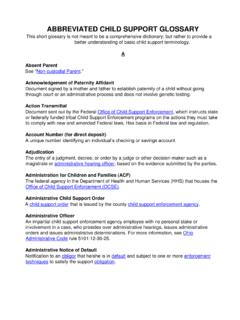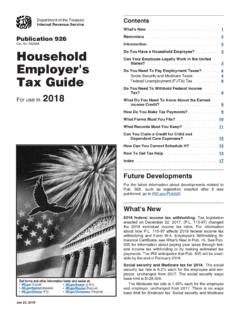Transcription of WAGE WITHHOLDING FOR DEFAULTED STUDENT LOANS A …
1 wage WITHHOLDING FOR DEFAULTED STUDENT LOANS A HANDBOOK FOR EMPLOYERS Revised June 18, 2008 2 TABLE of CONTENTS A Letter to Employers ..3 The STUDENT loan Program .4 5 The Basic Steps Employers Follow for WITHHOLDING .. 6 Employer Notification .. 6 Amount of WITHHOLDING .. 7 How to Remit the Earnings Withheld .7 8 When to Stop WITHHOLDING .. 9 Employer Compliance .. 9 Inquiries .. 10 Public Law 102 164; 20 1095 a et seq.. 10 11 Privacy Act Notice .. 12 Employer Instructions for Complying with the Order of WITHHOLDING .. 13 15 Attachments & Instructions Attachment A1 Order of WITHHOLDING from Earnings .. 17 Attachment A2 Second Notice of Order of WITHHOLDING from Earnings .. 18 Attachment B1 Employer Acknowledgment of wage WITHHOLDING .. 19 Attachment B2 AWG Worksheet Instructions ..20 Attachment B3 AWG WITHHOLDING Worksheet ..21 Attachment C Release of Order of WITHHOLDING from Earnings .22 Attachment D Employer Acknowledgment of Release of Order of WITHHOLDING .
2 23 Attachment E Employer Notice of Change of Employment .. 24 List of Guarantors .. 25 3 Dear Employer: The Federal Family Education loan Program (FFELP) provides low interest LOANS for postsecondary education. This program is administered by guarantors, such as USA Funds on behalf of the federal government. When borrowers fail to repay these LOANS , one of the methods for collecting payment on these DEFAULTED FFELP LOANS is Administrative wage Garnishment. AWG permits wage garnishment without the issuance of a court order. A federal statute (20 USC 1095a et. seq) that supersedes state law authorizes this process. The text of the federal statute authorizing Administrative wage Garnishment appears on pages 10 11 of this Employer Handbook. Please read carefully the details and instructions that follow in the attached Employer Handbook. An Order of WITHHOLDING from Earnings, accompanied by the Employer Handbook is being provided to you because valid records indicate your employee is a debtor who has DEFAULTED on a FFELP loan .
3 Prior to our contact with you, notification of this debt was provided to the debtor. He/she was allowed sufficient opportunity to review USA Funds records relating to the debt, make voluntary arrangements to resolve the debt or be granted a hearing regarding any existing disputes. We anticipate you will do your part to ensure borrowers who were assisted by the FFELP loan program repay their debts. Your cooperation with the AWG program will allow others to continue to receive assistance to pursue postsecondary education, which results in a more educated workforce. Additionally, you are contributing to the reduction of taxpayer dollars necessary to fund the loan program. Thank you for your participation. If after reading the following document in its entirety, you have questions, please contact the collection agency listed on the Order of WITHHOLDING from Earnings that you received. 4 THE STUDENT loan PROGRAM PROGRAM OVERVIEW The Federal Family Education loan Program, formerly called the Guaranteed STUDENT loan Program, was created by the Higher Education Act of 1965 in an effort to provide incentives for the use of private capital to fund low interest, long term LOANS for postsecondary education.
4 students go to private lenders for an education loan , and the lender s risk is nearly eliminated by a guarantee from the federal government. Guarantors such as USA Funds handle the administration of the loan program at the state level on behalf of the federal government. Guarantor administrative responsibilities include the loan guarantee, claim payment, compliance with STUDENT loan regulations, and collection of DEFAULTED LOANS . When a STUDENT fails to repay the loan and enters default (becomes 270 days past due), the holder of the loan (s) files a claim with the guarantor to cover the amount. The guarantor examines the claim to ensure that it was properly serviced by the lender, and pays the lender. Once a claim is paid, the guarantor files for reinsurance on the loan (s) with the Department of Education. At the same time, the guarantor begins collection efforts by contracting with various collection contractors. These contractors use various tools, including phone calls, letters, and WITHHOLDING federal (and in some cases, state) tax refunds and other benefit payments from DEFAULTED borrowers.
5 DEFAULT RATES Most students repay their debts. Approximately 15 percent of borrowers in this program fail to repay their LOANS . Many of these borrowers are employed and able to make payments. DEFAULT PREVENTION and COLLECTION The FFELP offers a variety of incentives and penalties designed to prevent STUDENT loan defaults. As a result, guarantors have substantially increased default prevention efforts. In addition, Congress has passed a law that will help guarantors and the Education Department collect on these DEFAULTED LOANS through the administrative WITHHOLDING of a DEFAULTED borrower s wages. LEGISLATIVE AUTHORITY Public Law 102 164; 20 1095(a) et seq. allows USA Funds to administratively garnish up to 15 percent of the debtor s disposable pay until the DEFAULTED loan has been paid in full. This law supersedes any state s laws governing wage garnishment. USA Funds believes wage WITHHOLDING will encourage many DEFAULTED borrowers to repay their LOANS .
6 In those cases where borrowers continue to refuse to honor their obligations, wage WITHHOLDING becomes an effective debt collection tool. 5 COLLECTION AUTHORITY The Education Department permits a guarantor to contract with a collection contractor to perform, on the guarantor s behalf, many of the activities needed for the agency to collect by AWG under the federal regulations governing AWG (34 CFR (b)(9). Such administrative activities include the identification of suitable candidates for wage garnishment if done in accordance with specific standards adopted by the guarantor; obtaining employment information on these individuals for the exclusive purpose of garnishment; sending candidates selected for garnishment a notice prescribed by the guarantor to explain the garnishment action the guarantor proposes to take, the debtor s right to object to the proposed action, and an opportunity to negotiate an alternate repayment arrangement; responding to inquiries from notified candidates regarding requests for documents pertaining to the debt, for a hearing, or for repayment arrangements and negotiating such arrangements; and receiving garnishment payments from a debtor s employer.)
7 6 BASIC STEPS to FOLLOW THE wage WITHHOLDING PROCESS PROCEDURE 1. Read the Order of WITHHOLDING from Earnings. It contains the instructions on how to withhold and pay the required amounts. 2. Calculate and deduct the amount to be withheld from the debtor s pay for the first pay period that occurs after the employer receives the WITHHOLDING order. 3. Send the amount deducted to the collection agency according to the instructions. 4. Repeat steps 2 and 3 each payday EMPLOYER NOTIFICATION The collection agency will send the employer an Order of WITHHOLDING from Earnings form which provides the debtor s name, address, and Social Security number as well as instructions for WITHHOLDING . An additional copy of the Order is provided for you to give to the debtor. A sample form is provided as Attachment A. EMPLOYER ACTION Employers should respond by completing and returning the Employer Acknowledgment of wage WITHHOLDING form (Attachment B1) within 10 business days.
8 If the debtor no longer is employed by your organization when you receive the Order, simply indicate this fact on the form and return the form to the indicated mailing address. EMPLOYEE NOTIFICATION The debtor already will have been given notice that WITHHOLDING will occur. Before you receive an order, the debtor has received: Numerous notices of delinquency and a Notice Prior to wage WITHHOLDING . An opportunity to contest the WITHHOLDING and information about his or her rights and responsibilities in the process. An opportunity to avoid wage WITHHOLDING by entering into a voluntary repayment agreement with USA Funds. You have received the Order of WITHHOLDING from Earnings because the debtor: Did not request such a hearing within the time required under the law; or The hearing was held and the hearing officer determined the debtor did not have sufficient grounds to avoid garnishment 7 AMOUNT of WITHHOLDING The instructions below explain how to calculate the amount of earnings to be withheld.
9 1. Read the Order of WITHHOLDING from Earnings form. 2. Identify the debtor named in the Order. 3. Identify the debtor s gross earnings for the pay period. Earnings of the debtor represent the compensation paid or payable for personal services, whether denominated as wages, salary, commission, and bonus or otherwise. 4. Identify amounts that can be excluded from WITHHOLDING . These are limited to amounts required by law to be held, such as state (if applicable) and federal income tax, federal FICA or OASI tax (Social Security). The employer should not include deductions for savings bonds, employee contributions to retirement plans or health insurance, for example. 5. Calculate disposable earnings by subtracting excluded amounts (step 4) from the debtor s gross earnings (step 3). 6. Calculate the required WITHHOLDING by multiplying the debtor s disposable earnings (step 5) by The result is the amount to withhold from the debtor s wages each payday.
10 The employer may round off the figure to a flat dollar amount, as long as the resulting figure does not exceed 15 percent of the debtor s disposable pay. HOW to REMIT the EARNINGS WITHHELD 1. Process a check for the required WITHHOLDING amount calculated according to the instructions above. Make checks payable to the collection agency that sent you the Order of WITHHOLDING from Earnings. 2. Be sure each check includes the information below. Debtor Name Debtor Social Security Number Employer Name Notification Indicating This Is A wage WITHHOLDING Payment or Payments Employer s Federal Employer Identification Number FREQUENCY of PAYMENT Although deductions should be made at each pay period, whether weekly, bi weekly, semi monthly, or other frequency, remittance to the collection agency need not be made more than once each month. The employer is not required to change its normal pay and disbursement cycles to comply with the WITHHOLDING Order.










